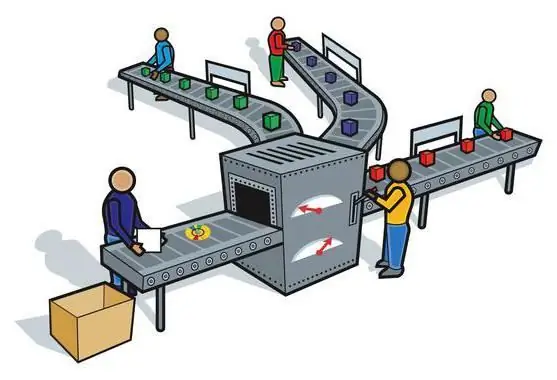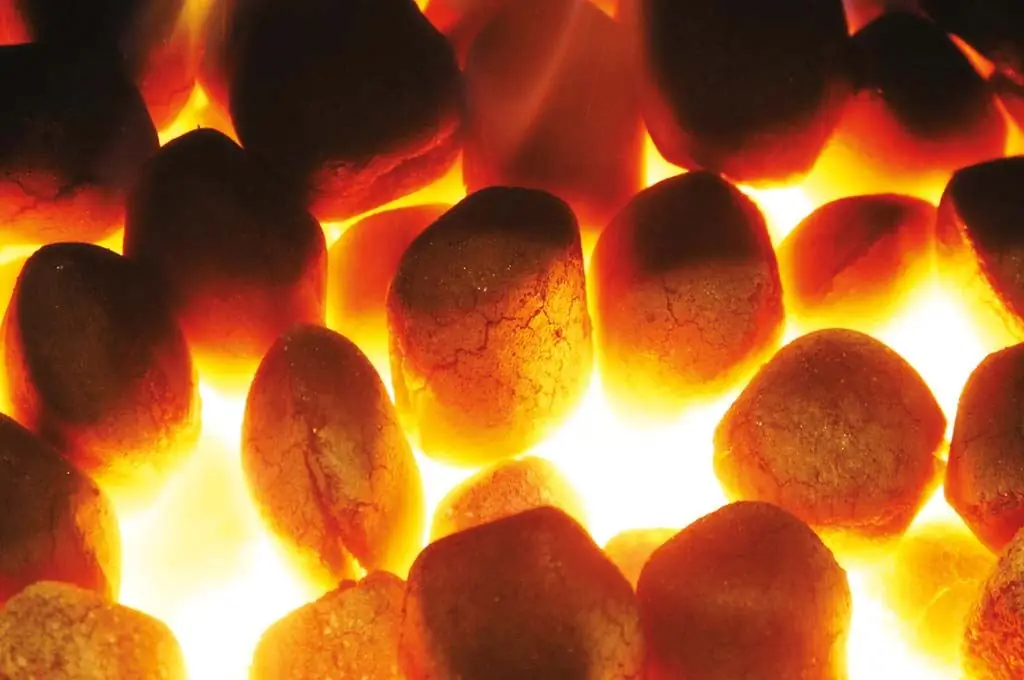2025 Author: Howard Calhoun | [email protected]. Last modified: 2025-01-24 13:10:26
All types of fuel, regardless of their state of aggregation, are similar in one thing: the main element in their composition is carbon. Complex organic compounds based on it eventually turn into a combustible substance - fuel.
Firewood

Firewood is a solid fuel, the extraction of which does not require geological development and surveys. Wood heating in the country is the most common due to its availability and low cost compared to other types of fuel. The modern market for heating appliances also offers a wide range of boilers of various designs designed for the use of firewood.
Characteristics of firewood
Dry hardwood firewood such as birch has the following characteristics:
- High calorific value. The carbon content in this solid fuel is 50-58%, the specific heat of combustion is up to 15 MJ/kg.
- After combustion, a minimum amount of ash is produced.
- No sulfur in the composition.
- Wood combustion does not adversely affectenvironment.
Among the shortcomings is a large amount of fuel: a supply of firewood for a full heating season takes up a lot of space. With this in mind, the optimum moisture level is reached after two years of wood aging, it is stored for several years.
Complaints are caused by the need for pre-treatment of fuel: sawing, splitting, collecting in a woodpile. Chopped firewood costs several times more. Another nuance - the heat of combustion of fuel directly depends on the moisture content in it. For this reason, the storage location should be chosen in such a way that the firewood is not exposed to precipitation and moisture.
Fuel briquettes

An alternative to the usual firewood is a solid fuel called eurowood. Wastes from the food industry, agriculture and woodworking are pressed into bricks or logs. In the production of this type of solid fuel, no adhesives are used: the raw material is steamed and then pressed using lignin, a natural polymer.
Several types of fuel briquettes are widely available for sale:
- Pini kei. Made in the form of four- or six-sided logs with longitudinal holes. Pini-kay briquettes are produced on screw presses under a pressure of about 1000 bar, which ensures their high density - from 1.08 to 1.40 g/cm3. Holes in the logs increase the burning area of solid fuel and improve air circulation in the furnace, which increases the efficiency of burning briquettes. heat treatmentgives pini kei a darker color and improves moisture resistance while improving burning performance.
- Nestro, or nelson. One of the types of solid fuel produced on a hydraulic or shock-mechanical press under a pressure of 400-600 bar, which affects the density of the finished product - 0.9-1.2 g/cm3. Briquettes are made in a cylindrical shape, may or may not have a hole.
- Ruf. Under the brand name RUF, fuel briquettes in the form of a brick are produced. For production, hydraulic presses are used at a pressure of 300-400 bar. Their density is small - 0.75-0.8 g/cm3.
In terms of efficiency, fuel briquettes are practically not inferior to ordinary firewood, since they are made from the same wood. Minimum humidity and high density of briquettes provide them with high specific heat of combustion.
The quality and type of feedstock also affect the calorific value of eurofirewood. The most "warm" are briquettes made from sunflower husks. The oil included in the husk has a higher calorific value than wood, and as an additional bonus, the minimum amount of ash formed as a result of combustion acts. The disadvantage of such solid fuel is the heavy soot pollution of the chimney due to the presence of oil in the composition.
In terms of heat transfer, the second place is occupied by sawdust briquettes - they are not inferior to wooden counterparts. Logs pressed from rice husks have minimal heat dissipation.
How to choose eurofirewood

When choosing fuel briquettes, the calorific value of the raw material, its ash content and the percentage of ballast substances are taken into account. Solid fuel from rice husks has not only a minimum specific heat of combustion, but also a high ash content - about 20%.
When buying, you should also pay attention to the size of the briquettes. Solid fuel of high quality, produced on modern equipment, has a length of 250-350 mm and a thickness of 60-80 mm. Cheap raw materials are thinner and shorter, which is due to a looser structure: logs of large dimensions will fall apart under their own weight. Naturally, this affects the calorific value of the fuel.
Advantages and disadvantages

Solid fuel is one of the most environmentally friendly types of fuel. Fuel briquettes are made from industrial waste - rice husks, sawdust, buckwheat and sunflower husks, corn stalks, hay and other raw materials.
Unlike the usual wooden logs, briquettes are more technologically advanced and compact: thanks to their cylindrical shape, they can be stacked in tight piles. Despite the obvious advantages, eurofirewood has its drawbacks:
- High cost. There is an opinion that fuel briquettes are more profitable from an economic point of view. It is argued that at a higher cost per ton, burning solid fuels releases more kilowatts compared to burning ordinary firewood. But in practice, the figures are somewhat smaller: eurofirewood emits more heat, but by about a third,in this case, an overpayment occurs.
- The need for proper storage. Sawdust briquettes are produced using a technology that excludes high humidity in the room. If they are stored in the same way as ordinary firewood, they will soon turn into raw materials - sawdust.
Fuel pellets - pellets

Identical raw materials are used for the production of fuel pellets - pellets. Their production was launched in Europe in the middle of the last century, and today pellet boilers are considered one of the most common heating appliances.
The raw materials milled into flour by crushers enter the press granulator, which forms granules about 50 mm long and 6-8 mm in diameter. Pellet size standards vary depending on the country of production. By analogy with fuel briquettes, pellets have low moisture content and high density.
The specific heat of combustion of pellets is identical to firewood - 3.5 kW/h. On sale you can find both light and dark pellets; the latter are thermally processed and are often referred to as bio-charcoal. Torrectification increases the calorific value of pellets, equating them to another type of solid fuel - coal.
Types of pellets

Fuel pellets are divided into three categories:
- Standard. Dark-colored pellets made from sunflower husks and buckwheat husks. The percentage of ash content of the "standard" should not exceed 3%. Affordable cost with high efficiency makes this viewpellet most popular.
- Premium. Light gray or white granules. They are characterized by a minimum level of ash content - 0.4% - and a high rate of specific heat of combustion.
- Industrial. Used in industry. The cost of dirty gray pellets is the lowest; made from wood waste.
Pellets are burned in specially designed boilers equipped with a fuel chamber and hopper designed for this type of fuel.
High-tech burner improves the efficiency of the pellet boiler compared to other solid fuel boilers and gas heating equipment.
Chips and sawdust

Sawdust and wood chips are not just raw materials, but also one of the types of long-burning solid fuels. Waste from the woodworking industry solves the problem of long burning, which is relevant for many heating appliances.
Maintaining a constant pressure in liquid fuel and gas boilers solves the problem of continuous fuel supply. The operation of solid fuel models requires the owner to constantly supply fuel due to the fixed size of the firebox. After the combustion of one portion of fuel, a new one is required. The bunker of boilers fed with sawdust ensures continuous operation for 10-12 hours.
Pellet and coal boilers have a similar design, while the problem of long burning in them is solved by using waste from the woodworking industry with maximum economic benefit: wood chips and sawdust are purchased at sawmills fora pittance.
Conclusion
Non-fossil solid fuel based on wood and industrial waste - affordable and efficient fuel. It is popular and widespread in Europe.
Recommended:
Production and production systems: concept, patterns and their types

Production systems are structures that involve people and equipment working together. They perform their functions in a certain space, conditions, working environment in accordance with the tasks
Diesel fuel: GOST 305-82. Characteristics of diesel fuel according to GOST

GOST 305-82 is outdated and replaced, but the new document, which came into force at the beginning of 2015, did not change the requirements for diesel fuel for high-speed engines so noticeably. Maybe someday such fuel will be banned for use altogether, but today it is still used both in power plants and on diesel locomotives, heavy military equipment and trucks, the fleet of which has been preserved since the days of the Soviet Union due to its versatility and cheapness
Fuel for boiler houses: features, types, characteristics and requirements

Types of fuel for boilers can be used different. Most water heaters run on gas. But electric, liquid and solid fuel boilers are also quite popular. In the latter case, the equipment can run on coal, wood or pellets
Diesel fuel is Types, grades, brands, classes of diesel fuel

Diesel fuel, which until recently was used in various industries, is becoming more in demand, as more passenger cars are produced with diesel engines, and owners of private vehicles have to understand the characteristics of this fuel
Fuel consumption of an aircraft: types, characteristics, displacement, amount of fuel and refueling

Fuel consumption of an aircraft is one of the important indicators of the efficient operation of mechanisms. Each model consumes its own amount, tankers calculate this parameter so that the airliner is not loaded with excess weight. Various factors are considered before allowing a departure: flight range, availability of alternate airfields, weather conditions of the route

